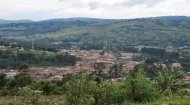
|
Nyakagyera Cave |
Nyakagyera Cave |
Nyakagyera Cave | Nyakagyera Cave |
Kabale is seen as a gateway to Bwindi Impenetrable National Park and Mahinga Gorilla National Park.
More >
|
|

One of the defining legends surrounding Nyakagyera speaks to the power of the cave’s protective magic. It is said that during a particularly brutal war, a revered leader or king (Mwami) was hidden deep within the cave’s recesses. The pursuing army searched the area relentlessly but could not find the secret entrance, which was only revealed by the sound of a specific, ritualistic drumbeat perceptible only to the faithful. The legend often concludes with the tale of the king emerging unharmed after the danger passed, proving that the spirits of the cave actively defend those who respect its sanctity. This mythology serves as an essential cultural anchor, reminding people that the land itself, and its hidden places, holds power and memory. Today, the cave is only home to bats and small birds and barely equates as a tourist attraction because few, if any tourists actually make the tortuous journey over rough, reclaimed wetland areas where no vehicle, not even a boda boda can pass. In fact, few residents of Kabale even know the cave exists, nor do they care much! Shrubs have grown to cover its entrance, and eucalyptus trees cover the hill it supports. Below lies a reclaimed wetland where vegetables, Irish potatoes, fruits, and other root tubers grow. To get to Nyakagyera Cave is a bit of a trek. Hire a taxi or get on a boda and enjoy the journey taking in local sights of clay moulding, charcoal stove making, women digging, and animals grazing, until you reach Kigezi College Butobere Secondary School. It's then on foot for another 5.6 miles until you reach the cave itself to witness an historical site bearing witness to the battles, cultural transitions, and resilience of the people who have called it home over millennia. Oh, and if you do visit Nyakagyera Cave, be careful not to get bitten by the bats, as many carry the Marburg virus. |








